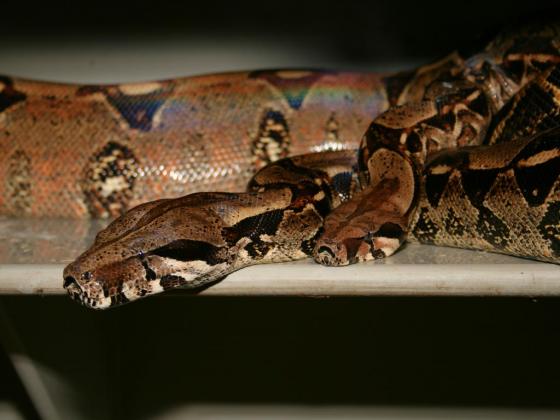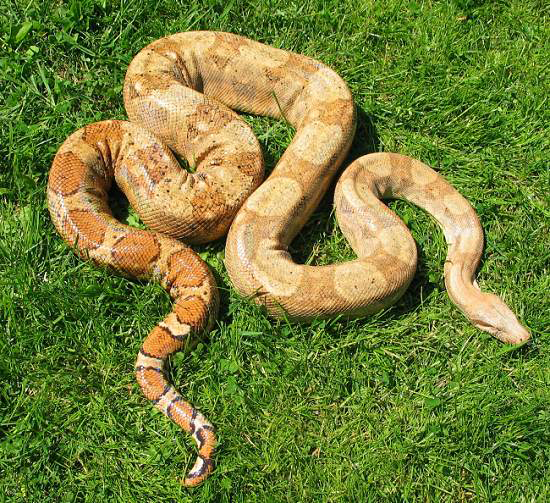
During the day, they slither to the bottom of a tree to rest especially dawn and in the afternoon. Boa constrictors are viviparous, incubating the eggs inside themselves and giving birth to live young. Whenever its hungry, the 4-meter-long snake wraps itself around rodents, birds. Also called the red-tailed boa, the boa constrictor is a species of large, heavy-bodied snake found in the Western Hemisphere, throughout Central and South. They might hiss or bite if they feel threatened, but consistent handling usually will make them tame and not so defensive.


Some Hog Island Boas have dark grey or cream coats, which have dark brown patterns on them. The fearsome boa constrictor (Boa constrictor) lives up to its name. Scientific Names: Boa constrictor constrictor, Boa constrictor imperator Adult Size: 8 to 10 feet long Life Expectancy: 20 to 30 years on average Boa Constrictor Behavior and Temperament Boas are typically active, alert snakes. The tails of these snakes are mainly orange though for those placed in captivity they appear pink. Regionally, Epicrates exul is found on the Little Bahama Bank, Epicrates striatus on the Great Bahama Bank and Epicrates chrysogaster in the southern Bahamas. A staple of private collections and public. The species is native to tropical South America. Scientific name: Boa constrictor Kingdom: Animalia Phylum: Chordata Class: Reptilia Order: Squamata Family: boidae Genus: Boa Species: B. The boa constrictor is a member of the family Boidae. Like pythons, boas are primitive snakes that have vestigial remnants of the pelvis. The average length of an adult Hog Island Boa ranges between four feet and six feet the female boas are larger than male boas. Endangered Species of The Bahamas BAHAMIAN BOA CONSTRICTOR Artwork by Melissa Maura SCIENTIFIC NAME There are three species of boa constrictors (fowl snakes) found in The Bahamas. The boa constrictor (scientific name also Boa constrictor), also known as the red-tailed boa, is a species of large, non-venomous, heavy-bodied snake that is frequently kept and bred in captivity. Boa constrictors are members of the subfamily Boinae in the family Boidae. People mostly confuse the Hog Island Boas with Clouded Boas due to its small structure this species of boas are easy to maintain because they have less demands in terms of care. Other common names include Hog Island Boa and the Hog Island Boa. The boa constrictor (Boa constrictor), also called the red-tailed boa or the common boa, is a species of large, non-venomous, heavy-bodied snake that is. People normally refer to this snake by its common name, which is boa-Hog Island this is a common thing with all boats except the boa constrictor constrictor. The Hog Island species have a lifespan of about fifteen years when in captivity. These snakes originate from the Cayos Cochinos Islands and their level of compatibility is average. Once the snake has bitten its prey to hold on to it, it constricts. They are named for their method of predation: constriction. Fun Facts Of all the boas, constrictors can live in the greatest variety of habitats. They are named after their mode of predation: constriction. Specimens from the Amazon River basin tend to grow the largest, are much more docile than their Northern relatives and attain lengths of 79 feet (2.12.7 m), while the overall average size is closer to 6 feet (1.8 m). Boa constrictors are nonvenomous snakes found in Central and South America.

#Scientific name for boa constrictor update#
Taxonomy of the family Arenaviridae and the order Bunyavirales: update 2018.The Boa constrictor ssp, alternatively known as Hog Island Boa, is in the boa species. The boa constrictor gets its name from the manner in which it captures and kills its prey. Red-Tailed Boa (Boa Constrictor Constrictor) If somebody says they own a boa constrictor, this is probably the snake they mean. The name recently suggested for this morphological variant, is Corallus batesii Henderson.

Maes P, Alkhovsky SV, Bào Y, Beer M, Birkhead M, Briese T, Buchmeier MJ, Calisher CH, Charrel RN, Choi IR, Clegg CS, de la Torre JC, Delwart E, DeRisi JL, Di Bello PL, Di Serio F, Digiaro M, Dolja VV, Drosten C, Druciarek TZ, Du J, Ebihara H, Elbeaino T, Gergerich RC, Gillis AN, Gonzalez JJ, Haenni AL, Hepojoki J, Hetzel U, Hồ T, Hóng N, Jain RK, Jansen van Vuren P, Jin Q, Jonson MG, Junglen S, Keller KE, Kemp A, Kipar A, Kondov NO, Koonin EV, Kormelink R, Korzyukov Y, Krupovic M, Lambert AJ, Laney AG, LeBreton M, Lukashevich IS, Marklewitz M, Markotter W, Martelli GP, Martin RR, Mielke-Ehret N, Mühlbach HP, Navarro B, Ng TFF, Nunes MRT, Palacios G, Pawęska JT, Peters CJ, Plyusnin A, Radoshitzky SR, Romanowski V, Salmenperä P, Salvato MS, Sanfaçon H, Sasaya T, Schmaljohn C, Schneider BS, Shirako Y, Siddell S, Sironen TA, Stenglein MD, Storm N, Sudini H, Tesh RB, Tzanetakis IE, Uppala M, Vapalahti O, Vasilakis N, Walker PJ, Wáng G, Wáng L, Wáng Y, Wèi T, Wiley MR, Wolf YI, Wolfe ND, Wú Z, Xú W, Yang L, Yāng Z, Yeh SD, Zhāng YZ, Zhèng Y, Zhou X, Zhū C, Zirkel F, Kuhn JH Tavallinen suomalainen mies virus clone TSMV-2_L_F15-133 Z-protein and RNA-dependent RNA polymerase genes, complete cds.


 0 kommentar(er)
0 kommentar(er)
